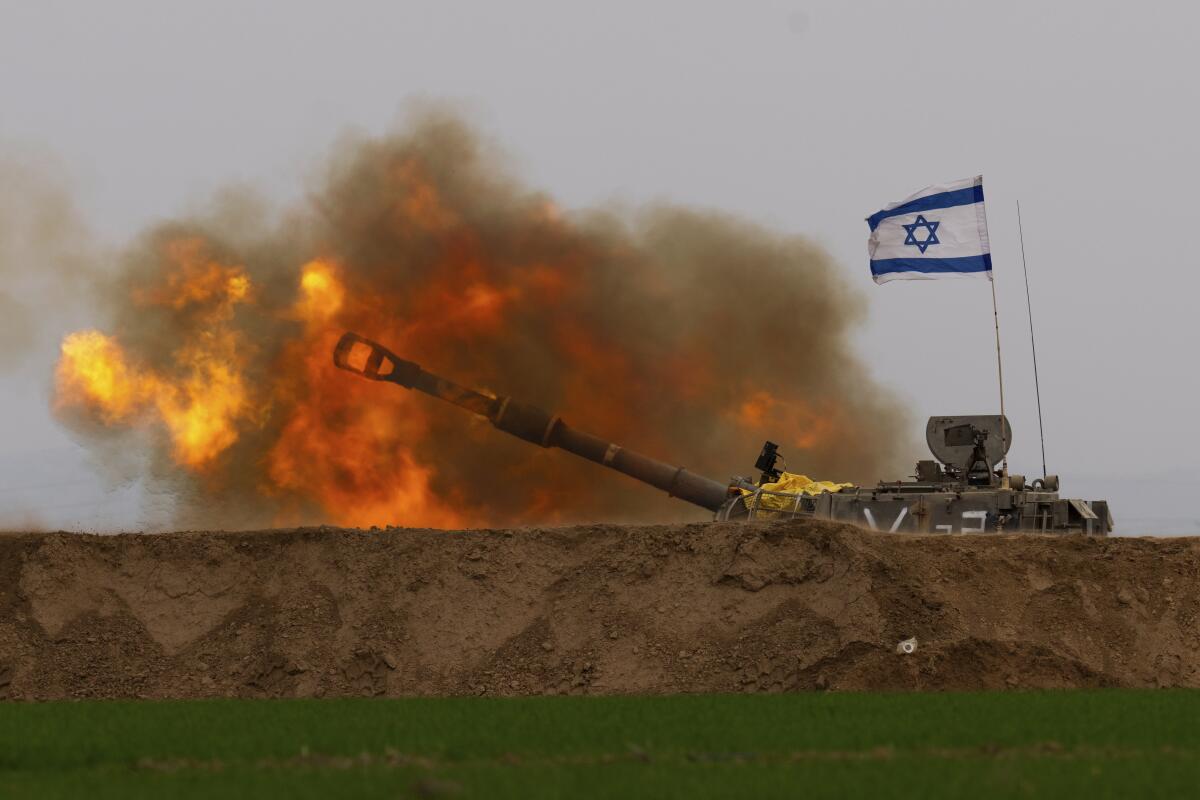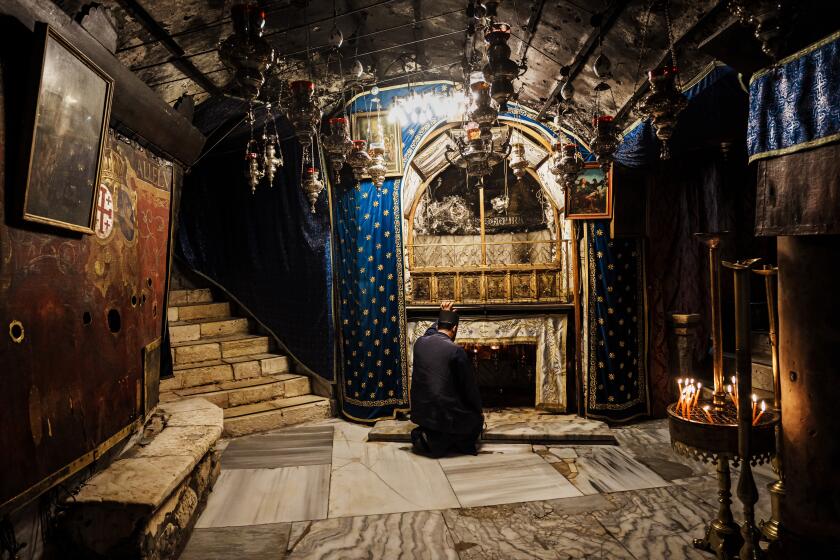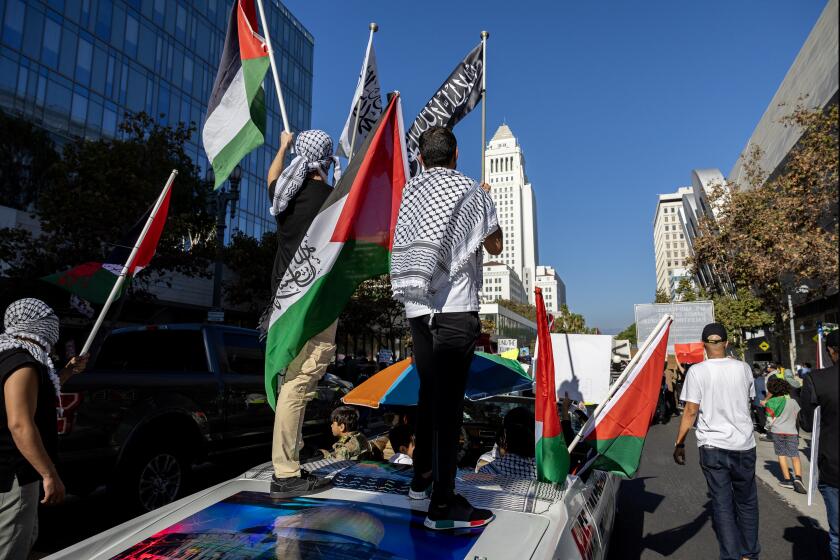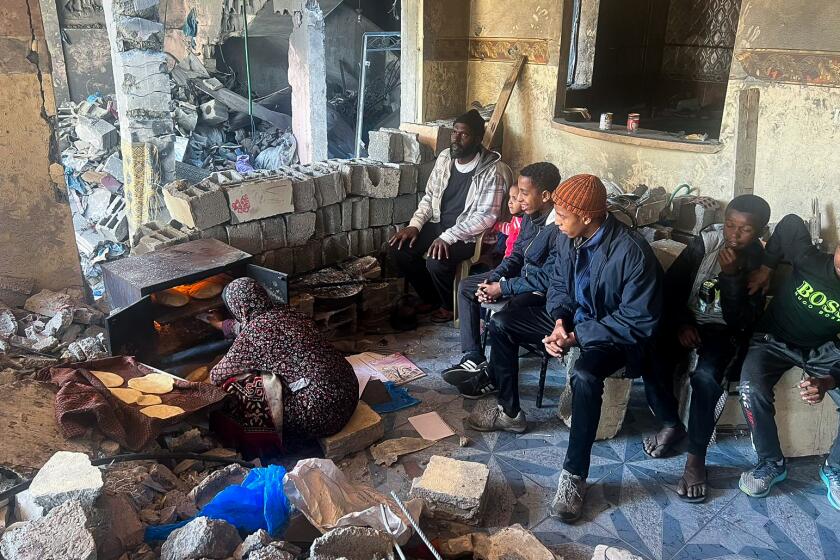More than 1 in 4 people in Gaza are starving because of war, U.N. report says

- Share via
RAFAH, Gaza Strip — More than half a million people in the Gaza Strip — a quarter of the population — are starving, according to a report Thursday by the United Nations and other agencies. The report highlights the humanitarian crisis caused by Israel’s bombardment and siege on the territory in response to Hamas’ Oct. 7 attack in southern Israel, which killed at least 1,200 people, mostly civilians.
The extent of the population’s hunger eclipsed even the near-famines in Afghanistan and Yemen of recent years, according to the report’s numbers. The report warned that the risk of famine is “increasing each day,” blaming the hunger on insufficient aid entering Gaza.
“It doesn’t get any worse,’’ said Arif Husain, chief economist for the U.N.’s World Food Program. “I have never seen something at the scale that is happening in Gaza. And at this speed.”
Israel says that it is in the final stages of clearing out Hamas militants from northern Gaza, but that months of fighting lie ahead in the south. The war sparked by Hamas’ rampage and hostage-taking in Israel has killed about 20,000 Palestinians. About 1.9 million Gaza residents — more than 80% of the population — have been driven from their homes, with more than a million now cramming into U.N. shelters.
For a Thai farmworker taken hostage by Hamas militants Oct. 7, memories of Israel and Gaza are of love, grief and heartbreak for those she left behind.
The war has also pushed Gaza’s health sector into collapse. Only nine of its 36 health facilities are still partially functioning — and all are located in the south, the World Health Organization said. WHO relief workers on Thursday reported “unbearable” scenes in two hospitals they visited in northern Gaza: Bedridden patients with untreated wounds cry out for water, the few remaining doctors and nurses have no supplies, and bodies are lined up in the courtyard.
Bombardment and fighting continued Thursday, and internet and other communications that had been knocked out for several days gradually began to return across the territory.
U.N. Security Council members are negotiating an Arab-sponsored resolution to halt the fighting in some way to allow for an increase in desperately needed humanitarian aid deliveries to Gaza.
A vote on the resolution, first scheduled for Monday, was pushed back again Thursday in the hopes of getting the U.S. to support it or allow it to pass after it vetoed an earlier cease-fire call.
U.S. Deputy Ambassador Robert Wood told reporters as he headed into a Security Council meeting on Syria, “We’re still working it. We’re working it very hard.” He said there needed to be some changes in the text “that would make it worthy of our support.”
The U.S. has been struggling to change the text’s references to a cessation of hostilities in the Israel-Hamas war, but the sticking point is the inspection of aid trucks allowed into Gaza — amid Israel’s blockade — to ensure they are carrying only humanitarian goods. The latest draft called for the U.N. to take over the job from Israel.
Nathan Evans, the spokesman for the U.S. mission to the United Nations, stressed that the resolution’s goal is to expand aid deliveries into Gaza.
“There are still serious and widespread concerns that this resolution as drafted could actually slow down delivery of humanitarian aid by directing the U.N. to create an unworkable monitoring mechanism,” Evans told the Associated Press. “We must ensure any resolution helps and doesn’t hurt the situation on the ground.”
Thursday’s report from the U.N. underscored the failure of weeks of U.S. efforts to ensure greater aid reaches Palestinians. At the start of the war, Israel stopped all deliveries of food, water, medicine and fuel into the territory. After U.S. pressure, it began allowing a trickle of aid in through Egypt. But U.N. agencies say only 10% of Gaza’s food needs has been entering for weeks.
In Bethlehem, the West Bank town revered as Jesus’ birthplace, Christmas is all but canceled, in solidarity with Palestinians’ suffering in Gaza.
This week, Israel began allowing aid to enter Gaza through its Kerem Shalom crossing, bringing the number of trucks entering to around 190 on Wednesday, up from about 100 a day previously, according to the U.N. But an Israeli strike Thursday morning hit the Palestinian side of the crossing, forcing the U.N. to stop its pickups of aid there, according to Juliette Touma, spokesperson of UNRWA, the U.N. agency for Palestinian refugees. At least four staff members at the crossing were killed, a nearby hospital reported. The Israeli military said it struck militants in the area.
Israeli President Isaac Herzog said Israel has been working to increase its inspection of aid trucks to 300 or 400 a day and blamed the U.N. for failures in delivery. The amount of aid could triple “if the U.N., instead of complaining all day, would do its job,” he said, without elaborating on what more the U.N. should be doing.
Egypt’s Rafah crossing has limited capacity for trucks to cross. U.N. officials say delivery of aid within much of Gaza has become difficult or impossible because of fighting, and more than 130 U.N. personnel have been killed.
The report released Thursday by 23 U.N. and nongovernmental agencies found that the entire population in Gaza is in a food crisis, with 576,600 at catastrophic — or starvation — levels.
“It is a situation where pretty much everybody in Gaza is hungry,” said Husain, the World Food Program economist.
The lack of food and water weakens immune systems, making the population more vulnerable to disease, Husain said.
“People are very, very close to large outbreaks of disease because their immune systems have become so weak because they don’t have enough nourishment,” he said.
The Palestinian cause has never had so much support. But some Palestinian Americans say the movement has a messaging problem.
Husain said border crossings need to be operational to get in essential supplies, including food and water. And he said that humanitarian aid groups need safe access to the entire Gaza Strip.
Hundreds of people lined up at a soup kitchen in the southern Gaza town of Rafah on Thursday, waving cups and pots, waiting for soup to be served from huge vats hanging over wood fires. Rafah, by the Egypt border, is one of the few places that receives regular aid deliveries.
Aya Barbakh, a displaced woman, said she comes every day for food. “Let us be in comfort like other people. We see people dying every day, and we want to die like them. We have been insulted and humiliated,” she said.
Israel has vowed to continue the offensive until it destroys Hamas’ military capabilities and brings home scores of hostages captured by Palestinian militants during their Oct. 7 cross-border attack.
Hamas fired a large barrage of rockets at central Israel on Thursday, showing its military capabilities remain formidable. There were no immediate reports of casualties or damage, but the attack set off air raid sirens in Israel’s commercial hub of Tel Aviv.
Hamas militants have put up stiff resistance lately against Israeli ground troops, and its forces appear to remain largely intact in southern Gaza, despite more than 2½ months of heavy aerial bombardment across the territory.
‘I just don’t know where we’ll go.’ It’s a question Palestinians ask over and over in Gaza as Israel ramps up bombardment after Hamas truce collapsed.
The United States, Israel’s closest ally, has continued to support Israel’s campaign while also urging greater efforts to protect civilians. The Biden administration wants Israel to shift to more targeted operations aimed at Hamas leaders and the group’s tunnel network.
On Wednesday, the WHO delivered supplies a day earlier to the Ahli Arab and Shifa hospitals, which are located in the heart of the northern Gaza battle zone where Israeli troops have demolished vast swaths of the city while fighting Hamas militants.
In the north over recent weeks, Israeli forces have raided a series of health facilities, detaining men for interrogation and expelling others. In other facilities, patients who are unable to be moved remain along with skeleton staff who watch over them but can do little beyond first aid, according to U.N. and health officials.
Ahli Arab Hospital is “a place where people are waiting to die,” said Sean Casey, a member of the WHO team that visited the two hospitals Wednesday. Five doctors and five nurses along with about 80 patients remain in Ahli, he said.
All of the hospital buildings are damaged except two buildings where patients are now being kept — the orthopedics ward and a church on the grounds, he said. He described entering the compound, strewn with debris and bearing a crater from recent shelling in the courtyard. Bodies were lined up nearby, but doctors said it was too unsafe to move them with fighting continuing outside, he said.
Inside the church, it was “an unbearable scene,” he said. Patients with traumatic wounds were struggling with infections. Others had undergone amputations.
“Many patients said they hadn’t changed their clothes in weeks,” he said. “Patients were crying out in pain but were also crying out for us to give them water.”
Jobain reported from Rafah, Jeffery from Cairo and Barry from Milan, Italy. Associated Press writers Lee Keath and Bassem Mroue contributed to this report.
More to Read
Sign up for Essential California
The most important California stories and recommendations in your inbox every morning.
You may occasionally receive promotional content from the Los Angeles Times.

















